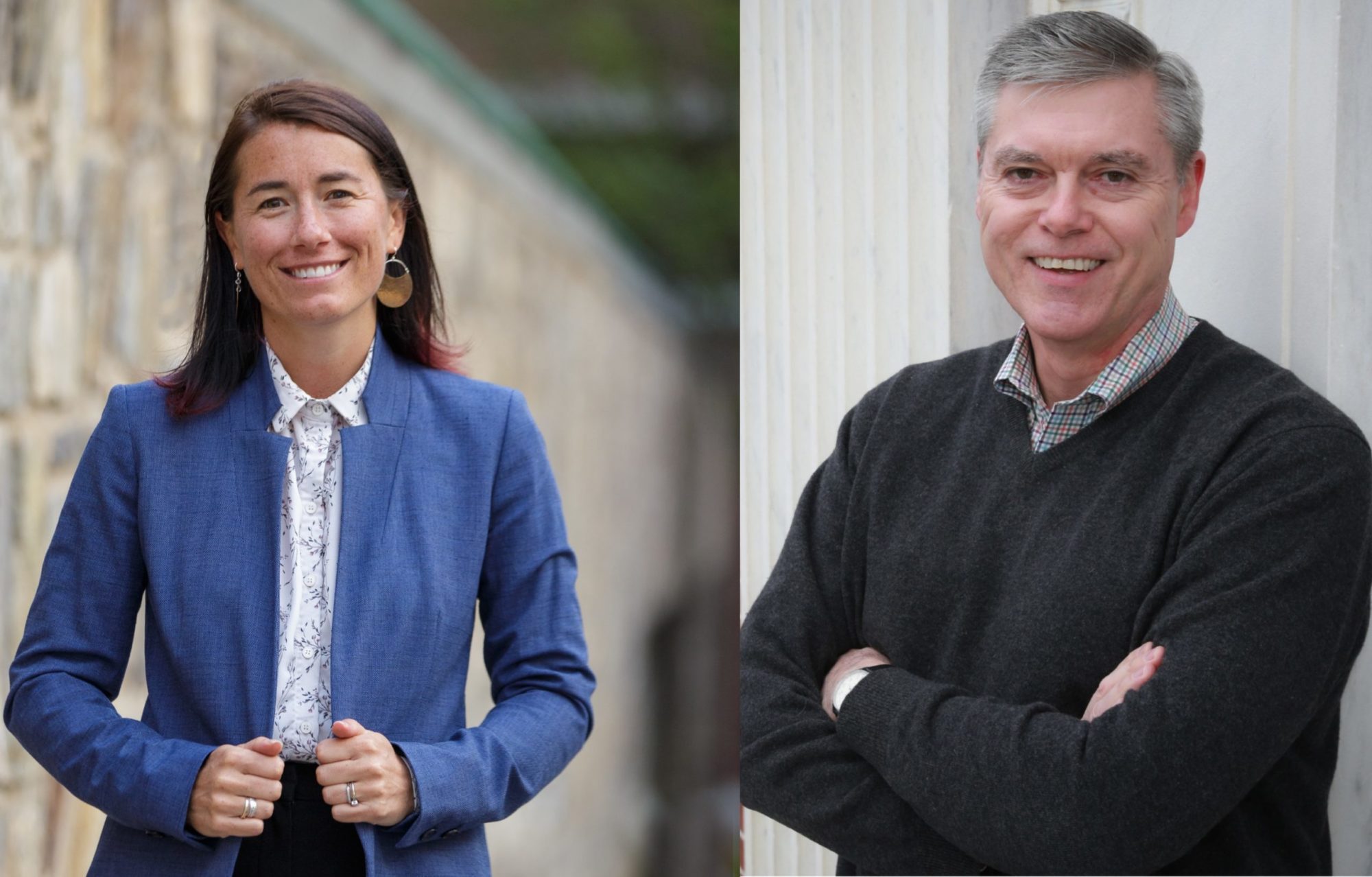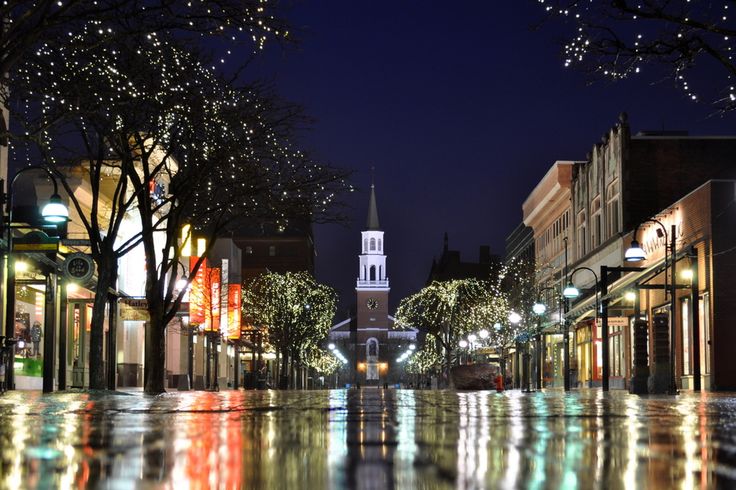A Vermont Prosecutor Expanded Restorative Justice. Now She’s Defending It At the Polls.
Sarah George championed alternative forms of accountability within the state’s criminal legal system. She faces a challenger who wants to curtail them.
Piper French | July 18, 2022


In 2017, when Sarah Fair George became the state’s attorney of Chittenden County, the most populous county in Vermont and home to Burlington, she knew she wanted to center restorative justice. In the years since taking office, she has promoted the practice as a more compassionate and holistic approach that can keep people out of the criminal legal system, encourage meaningful healing for victims, and ensure deeper accountability for those who cause harm.
George’s focus on restorative justice has been part of a broader effort to overhaul the criminal legal system in her county. She has declined to seek cash bail and prosecute possession of buprenorphine, a stance that helped inspire legislation that in 2021 made Vermont the first state to legalize possession of the prescription medication used to treat opioid addiction. Her office also adopted a policy of not pursuing charges where evidence was collected during traffic stops for a suspended registration or a broken brake light, a provocative attempt to reduce the racial bias that can lead to such stops in the first place.
“I think Sarah George has demonstrated a broader commitment to a reshaping and rethinking about what a just system looks like and what the role of a prosecutor is in the justice system than honestly any state’s attorney I’ve ever seen in Vermont,” said Bobby Sand, a former state’s attorney and founder of an innovative restorative justice program at the Vermont Law School (Sand supports George in his individual capacity).
On August 9, George will face Ted Kenney, who recently left a top post in the Vermont Attorney General’s Office to run in the Democratic primary for Chittenden County State’s Attorney. Kenney stresses that he’s no lock-em-up type, and has the CV to prove it: a longtime public defender and criminal defense attorney who has volunteered with a local transitional shelter and an organization that assists unhoused people.
But Kenney’s rhetoric in the race echoes that of more conservative candidates running against reform-minded incumbents around the country. His campaign has focused on retail theft and a recent increase in crime, arguing that reforms under George, including her traffic stop policy and what he sees as her reluctance to request strict conditions of pretrial release, are too extreme and undermine public safety.
Kenney also claims that George’s use of restorative justice has been too reflexive and sometimes applied inappropriately. Their conflict illustrates the intellectual and political challenges that restorative justice poses for reform-minded prosecutors. For those like George who see the practice as a philosophy, it’s a totally alternate framework for adjudicating harm, with many principles that stand in direct opposition to the way the current criminal legal system operates. Vermont’s groundbreaking but imperfect integration of restorative justice into that system also leaves prosecutors like George vulnerable to many of the same criticisms levied against other aspects of criminal justice reform: that it’s too lenient, will be exploited, or only works in low-level cases and can’t adequately address serious harm.
George is going farther than any state’s attorney in Vermont to integrate these two radically opposed systems. “Whether the public is ready to fully embrace that or not, I don’t know,” said Sand. “I guess we’ll find out in August.”
Where the traditional criminal legal system sees law, crime and punishment, restorative justice centers the concepts of relationships, harm, and repair. RJ, as Sand calls it, is “a philosophically different way to respond to harm.” It inverts the thinking behind some of the country’s most infamous tough-on-crime policies, like so-called three strikes laws that condemned people to life in prison if they accrued a third charge after already having two felonies on their record.
“I always say to my volunteers: do you believe in second chances—and do you believe in 22nd chances?” said Christalee McSweeney, director of the Williston Community Justice Center. “Because sometimes that’s what it takes.”
The Abenaki and other tribes indigenous to Vermont would have practiced some form of restorative justice, according to Sand, but when it began to be reimplemented in the 1990s, by two department of corrections officials, it was within and around the criminal legal system: courts, jails, prisons, probation, parole. Today, restorative justice is practiced in Vermont in a number of different forms, from post-release accountability circles, a program that Sand estimates is the most robust in the country, to community mediation that elides the criminal legal system entirely, to diversion and pre-charge programs.
Becky Penberthy, the Adult Restorative and Volunteer Coordinator at the Burlington Community Justice Center (CJC), which handles the city’s pre-charge restorative justice cases, says the goal of the process is to help people work through what they did, why they did it, what impact it had on the person they hurt and the people around them, and what they might do to make amends. “When something terrible happens and you’re both in on it, it doesn’t matter what your role is, a relationship is created—and it’s a terrible relationship,” Penberthy said. “The relationship can be repaired, so that people can move on.”
Two important questions the Burlington CJC asks participants are: what were you thinking at the time and what have you thought about since? Penberthy considered a hypothetical situation with a participant who drank too much and got into a bar fight. In response to the first question, he might recall that he didn’t like how someone was looking at him; to the second, he might confess that he didn’t even clearly remember what happened, and that he felt ashamed for letting himself get so drunk.
Next in the process, the restorative justice practitioner would ask the participant to consider who’d been hurt: the guy he punched, obviously, but also the bouncer, who’d had to break up the fight; the bartender, who’d had to clean up the resulting mess; and his girlfriend, who had to pick him up from jail. Though these questions are the same for everyone, everything that flows from them must be tailored to the individual. The instigator of the bar fight, for instance, could be a college freshman with a fake ID who’s intoxicated in part by their newfound freedom, or someone who struggled with substance abuse for decades and might need treatment before being able to participate in the RJ process at all.
George first became a prosecutor in Chittenden County in 2011, where she was assigned to domestic violence cases. She had gone to law school to become a public defender, but this was one area where she felt forthright about seeking justice for victims. “In my head, I thought that meant some form of punishment, even jail,” she recalled. “What I learned really quickly was that most survivors of domestic violence didn’t really want any of that.”
Seeking other ways to remedy the harm that domestic violence caused, George discovered restorative justice—but quickly learned that Vermont prohibits its use in three cases: sexual assault, stalking, and intimate partner violence. Still, the experience helped her develop a different framework for thinking about harm and repair. When George was appointed as state’s attorney in 2017 after her boss left to become Attorney General, one of the first things she did was invite Chittenden County’s CJCs in to discuss the practice with her staff.
Most restorative justice cases that the state’s 17 CJCs receive are referred there directly by law enforcement. But how many and what type of cases police send over depends on how much the state’s attorney in question prioritizes restorative justice—meaning that CJCs in George’s jurisdiction are a lot busier than others. “It’s very clear that there’s Chittenden County and then there’s the rest of the state,” McSweeney said.
From the outset, George expanded her use of restorative justice in court. “Whenever our advocates would have conversations with victims that felt like it’d be a good fit, they would talk to them about it,” she said, and either recommend a restorative justice process instead of prosecution or as a condition of a case resolution. Then the pandemic hit. Caseloads skyrocketed, and the courts closed. George can’t explicitly tell police departments what to do, but she suggested that they expand their notion of what cases might be eligible; occasionally, she sent back cases that she thought would be a better fit for pre-charge restorative justice. The Williston CJC’s caseload went up so much that they dramatically expanded their volunteer base to meet demand.
George’s opponent, Kenney, partially blames this expansion of restorative justice for the recent rise in crime in Chittenden County; George responds by citing a Seven Days analysis of 10 years of data that shows overall crime has declined, adding that there are obvious external factors, like the pandemic itself, that explain the spike in theft-related crimes. While Kenney says he’s a fan of restorative justice and supports using it as a tool, he argues that it’s been applied too widely under George.
To McSweeney, the Williston CJC director, the pandemic actually facilitated the restorative justice process. She told Bolts that her office saw higher levels of engagement from both participants and victims under a new, virtual system. “They don’t have to come to an in-person meeting, they don’t have to worry about transportation or childcare,” she said. “I think for impacted parties, it’s easier to talk about what happened in the comfort of your own home on a screen rather than coming face to face with somebody.”


Another reason for the higher level of engagement, McSweeney said, is that participants might be leery of coming into the Williston CJC itself, since it shares an office with the town’s police department.
Herein lies the paradox: restorative justice is a critical tool for reducing the power and reach of the traditional criminal legal system, but the form of RJ that begins at the moment of harm (or the legal violation, in a more conventional framework) is usually practiced within it. Even if a community justice center’s restorative justice process precludes someone from ever getting a criminal record or having to appear in court, that person often still got there because of an arrest.
George’s attempts to expand direct referrals between law enforcement and CJCs shrinks the scope and reach of her office, a goal of many serious reform prosecutors nationwide. But the Vermont system relies on police as frontline arbiters of restorative justice, and the pandemic’s changes to operations have only strengthened that reality. In April 2020, George issued a memo encouraging police to consider sending more eligible cases to CJCs instead of to her office for prosecution. Prosecutors in George’s office may have less discretion over people’s lives now—but local law enforcement now has more. “It also does mean that we don’t have any way to track the potential disparities in who’s being referred and who’s not,” George noted.
Chittenden County is Vermont’s most diverse county, but it’s still more than 85 percent white. Burlington is over 80 percent white, and the police force has a documented history of stark racial bias in traffic stops, arrests of and use of force against Black civilians. Though CJCs and local police departments have tried to cut down on referral bias by creating lists of infractions that are suitable for restorative justice, it’s not unreasonable to think that such bias could still play a role in referrals to those programs. For police to properly screen people for restorative justice, they also need to be able to assess whether someone might be willing to take accountability for their actions. But the traditional criminal legal system enshrines the presumption of innocence: “We’ve literally trained people who have committed a crime not to talk to police, not to admit anything, and then not to take any responsibility,” said George. “So some of that can be really difficult to gauge immediately.”
In an interview, Kenney seemed less worried than George about the potential of bias in police referrals. He denounced her policy of not pressing charges based on evidence discovered during routine traffic stops, which she enacted to try to cut down the well-documented bias that can play into those decisions, as “radical,” saying he’d opt for continued anti-bias training instead. But he criticized George for ceding too much power to police by encouraging them to refer a wide range of cases to CJCs, saying he wants the state’s attorney to have more control in whether to bring the power of the criminal legal system to bear on a defendant.
“The more serious things—a repeat offender, or a felony level offense—I would want the police to refer that to the State’s Attorney’s office as the first step so that they can do a review,” he told Bolts. “That does not mean that the people who don’t make the cut for reparative boards are going to go to jail. One of the benefits of bringing a more serious case into the criminal justice system is there are more tools available.”
Practicing restorative justice within the confines of the criminal legal system, rather than pre-charge, means there are more established consequences for failing to follow through, which raises another philosophical conflict between these two opposing systems. “My philosophy and my understanding of restorative justice is that it’s voluntary, right?” McSweeney said. “And so the moment that it becomes a court condition, it’s no longer voluntary.”
Probably the biggest controversy over restorative justice, and certainly the biggest in the state’s attorney race, is the question of accountability: what happens when people stop participating in the process? It seems like everyone agrees that restorative justice doesn’t work unless the person is willing to participate. How could it? “People need to want to take accountability,” said George. “It’s a lot harder than just pleading guilty.”
The association of restorative justice with leniency rankles many of its acolytes. “Most people don’t know how much work goes into a particular case,” said McSweeney. “Most people don’t know what a restorative contract looks like. When I train law enforcement [about RJ,] when I give them a copy of what a contract looks like, they’re normally pretty shocked at the depth of what we ask people to do.”
Penberthy described the restorative justice “conference,” where the participant and their community volunteers talk through the harm caused and settle on a course of action intended to repair it. If the victim chooses to be present, they too will answer a series of questions, including: what was the hardest thing for you? In Penberthy’s experience, the answers are unpredictable and often surprising. A damaged car might mean more to its owner than just its monetary value—it might be a lifeline. A schoolyard threat might strike a particularly painful chord because the child’s parent had lingering trauma from a similar experience when they were in school. “In the best of situations, it becomes really quiet and really intimate,” Penberthy said. “And people really settle into this very, very challenging conversation.”
Still, McSweeney said that participation is essentially still voluntary in the pre-charge system, meaning there’s not a surefire mechanism for accountability when people simply drop out of the process. And this is what leaves the system most vulnerable to criticism from people like Kenney. His campaign website asserts that restorative justice “will never work if there is no consequence for refusing to engage in the process.” When people fail to complete the process, he said, “many cases are being accepted for prosecution by the state’s attorney, but some of them are not.” George said her office looks at each case where participants drop out: “In some cases we’ll take the case and in some cases we’ll say, like, it’s been nine months and they haven’t picked up anything else. So we’re not going to charge it at this point. But we decide with each case.”
When she volunteered on the reparative panel in the city of Winooski (akin to a local CJC) in 2018 and 2019, Kayla Loving thought long and hard about restorative justice’s ties to the traditional criminal legal system. “I think the assumption was: oh, this is restorative justice, you just work with the police department,” she said. “And that’s not the approach I wanted to take.”
Now, as the restorative justice coordinator for Spectrum Vermont, which provides youth and family services, Loving focuses on a more holistic vision of restorative justice that aims to strengthen community before the harm-repair framework begins. “The way that I think it should be implemented is, first by providing opportunities for people to learn from one another and be authentic with each other, so that they are comfortable with one another and really value each other as human,” she said. That way, “when harm does happen, which will happen, they already have a relationship in place.” She’s currently conducting listening circles with middle and high-schoolers; the group recently discussed how to support each other amidst the repeal of Roe v. Wade.
Though it wasn’t for her, Loving respects the work of the CJCs, noting that the Burlington office recently hired a community mediator to help resolve interpersonal disputes before the criminal legal system ever gets involved. “I do think it is having a positive impact on the community,” she told Bolts. “And I think it might have even more of an impact if we did focus on community-building in the first place and not just: okay, something happened. Now what do we do?”


